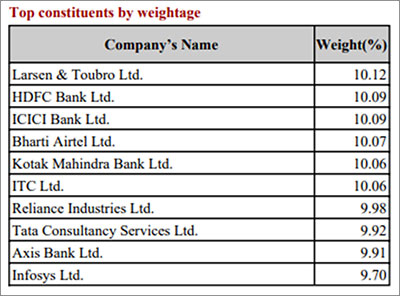Is Kotak Nifty Top 10 Equal Weight Index Fund the Smarter Way to Invest in Large Caps?
Apr 11, 2025
Kotak Mahindra Mutual Fund has launched Kotak Nifty Top 10 Equal Weight Index Fund, it is an open-ended scheme replicating/tracking the Nifty Top 10 Equal Weight Index.
In the current investment landscape, characterized by global trade tensions and market volatility, investors are increasingly seeking strategies that offer both stability and growth potential. The recent imposition of significant U.S. tariffs on Chinese goods has intensified market fluctuations, impacting major indices worldwide.
Amidst this backdrop, Kotak Mahindra Mutual Fund has launched the Kotak Nifty Top 10 Equal Weight Index Fund, which aims to provide investors with equal exposure to the top 10 companies in the Nifty 50 index, ensuring that each constituent has an identical weightage.
[Read: Equity Markets Crash Amid Trump's Tariff Wars: What Should Mutual Fund Investors Do Now]
The timing of this NFO aligns with a period where investors are looking for diversified investment avenues that can withstand market turbulence. By allocating equal weight to each of the top 10 companies, the fund offers a unique proposition for those aiming to diversify their portfolios within the large-cap segment.
Details of Kotak Nifty Top 10 Equal Weight Index Fund:
|
Investment Objective |
The investment objective of the scheme is to provide returns that, before expenses, corresponding to the total returns of the securities as represented by the underlying index, subject to tracking errors. However, there is no guarantee or assurance that the investment objective of the scheme will be achieved.
However, there is no assurance that the objective of the scheme will be realized |
|
Category |
Index Fund |
|
SIP/STP/SWP |
Available |
|
Plan |
|
Options |
-
Growth
-
Income Distribution cum capital withdrawal Option (IDCW)
|
|
Min. Investment (Index Fund) |
Rs 100/- and in multiples of Re 1 thereafter. Additional Purchase Rs 100/- and in multiples of Re.1/- thereafter |
Face Value |
Rs 10/- per unit |
|
Entry Load |
Not Applicable |
Exit Load |
NIL |
|
Fund Manager |
- Mr Devender Singhal
- Mr Satish Dondapati
- Mr Abhishek Bisen (for debt) |
Benchmark Index |
Nifty Top 10 Equal Weight Index |
|
Issue Opens: |
April 07, 2025 |
Issue Closes: |
April 21, 2025 |
(Source: Scheme Information Document)
What will be the investment strategy for Kotak Nifty Top 10 Equal Weight Index Fund?
Kotak Nifty Top 10 Equal Weight Index Fund will follow passive investment strategy with investments in stocks in the same proportion as in Nifty Top 10 Equal Weight Index.
The investment strategy would revolve around reducing the tracking error through regular rebalancing of the portfolio, taking into account the change in weights of stocks in the Index as well as the incremental collections/redemptions in the Scheme. Such rebalancing shall be done in accordance with timelines prescribed by SEBI from time to time.
Nifty Top 10 Equal Weight Index
Nifty Top 10 Equal Weight Index is a unique equity index that comprises the top 10 companies from the Nifty 50 index, based on their free-float market capitalization.

This index aims to provide a more balanced representation of leadership stocks across key sectors like banking, IT, energy, FMCG, and telecom. The equal allocation ensures that the performance of the index is not overly dependent on one or two outperformers, reducing concentration risk.
It also allows underperforming stocks a chance to contribute equally if and when they recover. A key feature of the index is its quarterly rebalancing, where weights are reset to 10% each.
The portfolio follows the index and therefore the level of stock concentration in the portfolio and its volatility would be the same as that of the index, subject to tracking error. Thus, there is no additional element of volatility or stock concentration on account of fund manager decisions.
How will the scheme allocate its assets?
Under normal circumstances, Kotak Nifty Top 10 Equal Weight Index Fund will hold an allocation of 95% to 100% in Equity & Equity related Securities covered by Nifty Top 10 Equal Weight Index, and 0% to 10% in Debt/ Money Market instruments.
Should investments in Kotak Nifty Top 10 Equal Weight Index Fund be considered?
In a market where large-cap dominance continues to play a key role, the Kotak Nifty Top 10 Equal Weight Index Fund brings a differentiated approach by giving equal exposure to India's top 10 companies by market capitalization.
Unlike traditional Nifty 50 or Nifty 100 funds that are market-cap weighted and heavily skewed towards a few top names like Reliance, HDFC Bank, and Infosys, this fund ensures that each of the top 10 companies holds an equal 10% weight (subject to rebalancing). This strategy reduces concentration risk and offers more balanced exposure among sector leaders.
What makes the fund attractive is its passive structure, which offers investors the benefits of low-cost investing with a rules-based allocation methodology. Since it invests only in 10 stocks with equal weights, it's relatively easier to understand and track.
Also, historically, equal-weighted indices have outperformed market-cap-weighted counterparts during market recoveries and broad-based rallies, where leadership rotates across sectors rather than staying concentrated in a few names.
However, the fund also comes with certain risks and limitations. Equal weighting means that underperforming large-caps get as much exposure as outperformers, which may drag down returns during phases where the top 2-3 market leaders are driving the index. The concentrated portfolio of just 10 stocks also limits diversification, making it more volatile compared to broader index funds.
For investors looking for a smart-beta approach within large-caps and who believe in mean reversion (where underperforming large-caps may bounce back), this fund offers a unique flavour. It's particularly suited for moderately aggressive investors who already have a core allocation to traditional large-cap or flexi-cap funds and want to complement their portfolios with a differentiated passive strategy.